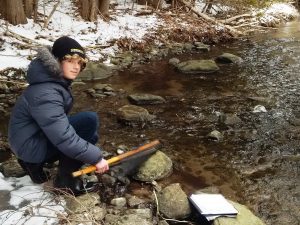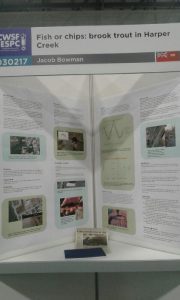Jacob Bowman, a 15 year old Peterborough high school student, is in Regina, Saskatchewan this week at the Canada Wide Science Fair (CWSF), presenting his research on the brook trout in Harper Creek. He qualified for the trip by winning the Peterborough Regional Science Fair last month.
Jacob’s project is called “Fish or chips? Brook trout in Harper Creek”. He has shown that the northern tributary of the creek, which runs along Rye St., has the highest quality trout habitat in the Harper Creek system. This is also the section that will be most affected by expansion of Rye St. The photo below shows Jacob’s CWSF presentation materials, including: a 5-page report on his research, his display poster, and a photograph of the material on display in Regina.
CONCLUSIONS OF JACOB’S RESEARCH
“North Harper Creek had all of the components necessary for brook trout residence. It had the most stable temperature range of the sampled sections. Different food sources for fish were recorded. Brook trout were regularly observed in the creek and more fish were seen there than in any other section. Some of the other sections of the creek system exceeded the thermal tolerance level for brook trout (20°C). North Harper Creek’s temperature remained well within the tolerance level year round. Years ago the creek was altered to fit the growing developments in the area. During this process a steep grade that may impede fish passage was created at the mouth of North Harper Creek. Trout in the creek appear to be disconnected from the other sections of the creek system. North Harper Creek contains a small relic population of native brook trout that are at risk from development including the Rye St. expansion. If Rye St. expansion is to proceed, brook trout in North Harper Creek may be at risk without proper management. A plan will have to be devised to accommodate the trout. An underground stream running through culverts is not survivable for brook trout (Georig et al. 2016). They would have to move to other more suitable habitat or die. A better option would be to leave the creek were it is and begin some habitat enhancement, such as tree planting. If the creek must be moved, it is critical that it intercepts groundwater sources, since brook trout require groundwater for reproduction (Meisner 1990). It is very important that this last southern Ontario stronghold of brook trout be preserved for future generations and becomes an example of good stream conservation.”
via Jeff Bowman

